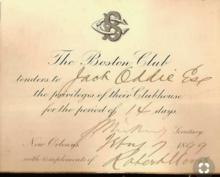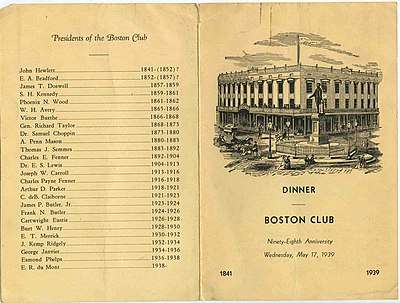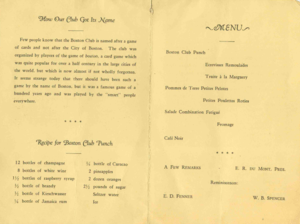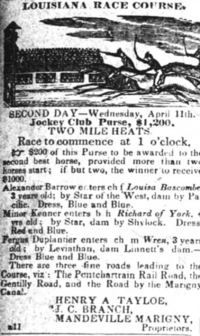The Boston Club
The Boston Club is a private gentlemen's club in New Orleans, Louisiana, USA, founded in 1841 as a place for its members to congregate and partake in the fashionable card game of Boston. It is the oldest remaining social club in the city, after the Elkin, Pelican and Orleans Clubs closed prior or due to the Civil War. [1] The clubhouse has been located at 824 Canal Street since 1884, formerly 148 Canal St, on the edge of the Central Business District. It was built in 1844 by James Gallier as a city residence for Dr. William Newton Mercer, a planter in Mississippi and surgeon from the War of 1812. The Club itself was organized in 1841, by thirty leading mercantile and professional men, they were the heads of families and men of substance on the shady side of life, yet full of bonhomie and fond of the card game of Boston, from which this club was christened. It epitomized the South’s most refined male tastes and attitudes, a member once noted, “Propriety of demeanor and proper courtesy are alone exacted within its portals.”[2]
The Boston Club of New Orleans, Dr. William Newton Mercer House | |
| Founded | May 15, 1841 |
|---|---|
| Location |
|
| Coordinates | 29°57′14.2″N 90°04′14.1″W |
History

Founded in 1841, The Boston Club is the third oldest Gentlemen’s City Club in the United States behind The Philadelphia Club in Philadelphia and Union Club of the City of New York in New York City. Members organized and rented rooms first at the Merchants Exchange, 126 Royal St, in the Vieux Carre, then 129/130 Canal Street until the Civil War when it closed from 1862-1866. After the war, it occupied 214 Royal Street (currently the Hotel Monteleone) until 1867 at which point it moved to 4 Carondelet Street, the former home of New Orleans financier, Edward J. Forstall. In 1884 it moved into its current clubhouse at 824 Canal Street (then known as 148 Canal Street) and the house was fully purchased by 1905.[3] The club was closed for 3 years during the Civil War.[4]

The Elkin Club, founded 1832 and shuttered in 1838, was the first social club in New Orleans. An open club, it sponsored dances and balls in the vicinity of Bayou St John and closed due to the financial crisis of 1837. The Pelican Club founded 1843 and folded at the beginning of the Civil War, confined its membership through blackball policies to bankers, cotton brokers, attorneys, physicians, and political leaders; the smallest lapse in credit spelled denial of membership. Younger gentlemen, who had been rejected membership to the Pelican Club, organized The Orleans Club in 1851 with similar, yet less restrictive, membership policies; but similarly shuttered its doors, never to reopen, at the outset of the Civil War. Members of this club full of jovial mirth would go on to found The Pickwick Club, the city's second-oldest Gentlemen's Club, and found modern-day Carnival.[5]
Initially, in more civilized times, the club was not closed, members could extend the club's hospitality to the guests-the club was theirs to use gratis; but as older, more conservative and narrow-minded men came to lead the club, these vestiges of hospitality were lost and anti-semitism set in. Ironically, Judah P. Benjamin and the first Rex, Lewis Solomon, both Jewish, had been members of the club.[6]
Famous guests
In 1873, Archibald Primrose, 5th Earl of Rosebery attended a luncheon.[7]
General Ulysses S. Grant lunched at The Boston Club in 1880.[8]
John J. Pershing visited on February 17, 1920.[9] [10] [11]
The Duke of Windsor and the Duchess of Windsor, February 21, 1950[12]
It was customary, until 1992, for Rex (King of Carnival) and his queen to lunch at the club after the Rex parade during Mardi Gras. In addition, the Boston Club entertained the queen of the carnival and her court during the parade. [13]
Notable members

- John Randolph Grymes Jr., FFV, Founding Member, attorney in New Orleans, member of the Louisiana state legislature, U. S. attorney for Louisiana district, and aide-de-camp to General Andrew Jackson during the Battle of New Orleans.[14][15][16]
- Gen. Dick Taylor, FFV, President of the Club 1868–1873, an American planter, politician, military historian, and Confederate general.[17][18]
- Judah P. Benjamin, QC, lawyer and politician who was a US Senator from Louisiana, a Confederate Cabinet Officer and, after his escape to the United Kingdom at the end of the American Civil War, an English barrister. He was a member of the Union Club of New York.[19][20][21]
- Edward A. Bradford lawyer and unsuccessful nominee to the United States Supreme Court. Law partner of Judah P. Benjamin.[22]
- Thomas Jenkins Semmes, President 1883–1892, was an American politician who served as a Confederate States Senator from Louisiana from 1862 to 1865. He was the 1st cousin of Capt Raphael Semmes, of the C.S.S. Alabama.[23]
- Samuel Horton Kennedy, President 1859-1861, brother of Hugh Kennedy Cotton Agent & Broker. Director Louisiana State Bank, Crescent Mutal Insurance Co., and New Orleans Gas Light Co.[24] [25]
- Hugh Kennedy (New Orleans) brother of Club President S. H. Kennedy. [26]
- Victor Burthe, President 1866–1868, son of Dominique François Burthe of Burtheville formerly a plantation of Bernard de Marigny, District Judge, Jefferson Parish.[27]
- Charles E. Fenner, President 1892–1904, Associate Justice Louisiana Supreme Court 1880-1893. [28]
- Dr. E. S. Lewis, M.D., President 1904–1913, father of gynecology in Louisiana.[29]
- Arthur D. Parker, President 1918–1921, founder of DR. G. H. Tichenor Antiseptic Co.[30], brother of John M. Parker.
- John M. Parker was an American Democratic politician from Louisiana, who served as the state's 37th Governor from 1920 to 1924. He was a friend and admirer of U.S. President Theodore Roosevelt.
- LeRoy Percy was an attorney, planter and politician in Mississippi. In 1910 he was elected to the United States Senate, serving until 1913.[31]
- Duncan F. Kenner was an American politician who served as a Deputy from Louisiana to the Provisional Congress of the Confederate States from 1861 to 1862. In 1864, he served as the chief diplomat from the Confederate States of America to Europe. Brother-in-law of Dick Taylor. [32]
- John Slidell was an American politician, lawyer, and businessman. A native of New York, Slidell moved to Louisiana as a young man and became a staunch defender of slavery as a Representative and Senator.[33]

- Pierre Soule was an Franco-American attorney, politician, and diplomat during the mid-19th century. Serving as a United States Senator from Louisiana from 1849 to 1853, he resigned to accept appointment as U.S. Minister to Spain, a post he held until 1855.[34]
- John Hamilton Fulton was president of National Park Bank from 1922 to 1927.[35]
- Eaton J. Bowers was a U.S. Representative from Mississippi.[36]
- Ernest L. Jahncke was United States Assistant Secretary of the Navy from 1929 to 1933.[37]
- Dr. Robert Tayloe Cook V, MD, FFV, of the Tayloe's of Mount Airy, VA. Uncle, H Tayloe, founded the Fair Grounds in 1838 with Marigny. Doctor of radiology at Baptist Hospital and past president of the Louisiana SNMMI. LD Addison, founder of MKC; club president Dick Taylor; J Grymes, and J Randolph of Nottoway, were relations.[38][39][40]
- Paul C. P. McIlhenny was an American businessman and executive at family-owned McIlhenny Company, maker of Tabasco sauce and other Tabasco brand products at Avery Island, Louisiana.[41][42][43][44]
- John Barnett Waterman was an American businessman, founder and executive at Waterman Steamship Corporation.[45]
- Stephen Duncan a major planter and banker in Mississippi in the antebellum years, migrating there from his home state of Pennsylvania after getting a medical degree. He became the wealthiest cotton planter in the South prior to the American Civil War, and also invested in railroads and Midwest lands. He was also a member of the Union Club of New York.[46]
- Bradish Johnson was an American industrialist. He owned plantations and sugar refineries in Louisiana and a large distillery in New York City. Her inherited Woodland Plantation from one of his brothers before the Civil War. He eventually purchased a number of other plantations in the area: Pointe Celeste, Bellevue, and the Orange Farm. He also acquired two plantations above New Orleans which he renamed after his married daughters: Whitney Plantation and Carroll Plantation.[47] [48]
- Walker Percy Obl.S.B. (May 28, 1916 – May 10, 1990) was an American writer, whose interests included philosophy and semiotics. Percy is known for his philosophical novels set in and around New Orleans, the first of which, The Moviegoer, won the U.S. National Book Award for Fiction.[49] Trained as a physician at Columbia University, Percy decided to instead become a writer following a bout of tuberculosis. He devoted his literary life to the exploration of "the dislocation of man in the modern age."[50] His work displays a combination of existential questioning, Southern sensibility, and deep Catholic faith. He had a lifelong friendship with author and historian Shelby Foote. Percy spent much of his life in Covington, Louisiana, where he died of prostate cancer in 1990.[51]
- Brooke Helm Duncan II was lawyer and civic leader in New Orleans. He reigned as Rex, king of Carnival, in 1971 and later served as the krewe’s leader in 1979, when the city’s police union went on strike over wage demands, thereby threatening the parades that constitute a vital part of New Orleans’ signature event. His father was New Orleans’ first director of city planning and conceived of the Civic Center. A fighter pilot who flew Corsairs in the Pacific Theater, he rose to the rank of captain. He earned a law degree at Tulane University and later managed several businesses, including Foster Awning Co., and was on the boards of directors for Entergy, Hibernia National Bank and the National Association of Manufacturers.[52]
Horse racing


Members of the Boston Club frequently patronized Jockey Clubs of the area, both the defunct Metairie Course (now the Metairie Cemetery) and the Fair Grounds Race Course, putting up high stakes purses to help offset the Jockey Club’s expenses. “The Boston Club…being composed of gentlemen who know ‘what’s what’...insured a numerous and distinguished attendance upon these occasions.” [53] Later noting “In the betting circles last evening.. The wagering was spirited and lively, and a good deal of money will change hands as a result.” [54] John Randolph Grymes owned philly Susan Yandal who raced in the first races at the Fair Grounds Race Course in 1838, his cousin Henry A. Tayloe, youngest son of turfsman John Tayloe III, was one of the proprietors along with local, Bernard de Marigny.
Homes of The Boston Club
- 1841–1855: Merchants Exchange, 126 Royal Street
- 1855–1862: 129/130 Canal Street
- 1862–1865: Club closed
- 1865–1867: 214 Royal Street
- 1867–1884: 4 Carondelet Street
- 1884: 824 Canal Street (then called 148 Canal Street)[55]
Description
Entering from Canal Street, the entrance to the club is a 10x12 vestibule framed by sidelights between engaged ionic pilasters and columns, with wooden door inscribed in frosted glass the club’s initials BC, opening into a marble paved hallway. Adjacent, to the left through a solid mahogany door[56], is a well-decorated parlor, extending fifty-five feet deep from the front facade. Here can be found leather chairs, lace curtains, and rockers with foremost men of New Orleans discussing current events. There is a reception area with a large round table behind leading into formal and informal dining areas. The formal dining room is forty-five feet deep, with molded stucco ceiling cornices and large center ceiling medallion of floral designs, and mantels finished in period Eastlake Style replacing earlier marble mantel carved with cherubs and flute players. The bar, located behind the informal dining area, is made of oak along with the wainscot running around the room. The second floor has two rooms, the front, a former card room while the rear is mainly used as a sitting room but can be converted easily to a dining room, it is finished in oak with cypress doors and is attached to a billiards room, board room and lady’s water closet. [57]
Significance
The Boston Club is a social club composed mainly of Anglo-American men. Its clubhouse has held lavish balls, regular daily lunches, and monthly dinners. Its events and social activities were the fodder for many newspaper and social columns at the turn of the 19th century and on into the 20th century. That a lavish club lifestyle could be centered around something as simple as a card game serves as a sign of prosperous times in New Orleans.
In popular culture
In The Moviegoer, by Walker Percy, "Uncle Jules" is said to have suffered a heart attack (his second) and died at the Boston Club on Mardi Gras.
See also
- Mystic Krewe of Comus
- The Pickwick Club
References
- Historical Sketch Book and Guide to New Orleans and Environs: With Map. Illustrated with Many Original Engravings; and Containing Exhaustive Accounts of the Traditions, Historical Legends, and Remarkable Localities of the Creole City, W. H. Coleman, 1885, p. 95
- Historical Sketch Book and Guide to New Orleans and Environs: With Map. Illustrated with Many Original Engravings; and Containing Exhaustive Accounts of the Traditions, Historical Legends, and Remarkable Localities of the Creole City, W. H. Coleman, 1885, p. 96
- Landry. History of the Boston Club. p. 7.
- Landry. History of the Boston Club. pp. 6–7.
- New Orleans Carnival Krewes: The History, Spirit & Secrets of Mardi Gras, Rosary O'Neill, Arcadia Publishing, Feb 11, 2014.
- "ArchivesSpace Public Interface | Archives and Special Collections at Tulane University".
- Landry. History of the Boston Club. p. 8.
- New Orleans Times. 3 April 1880. Quoted in Landry. History of the Boston Club. p. 8.
- http://www.neworleansbar.org/uploads/files/When%20General%20Pershing%20took%20Berlin_7-2(1).pdf
- The Haberdasher, Volume 71, Haberdasher Company, 1920
- Lords of Misrule: Mardi Gras and the Politics of Race in New Orleans, James Gill, Univ. Press of Mississippi, 1997, p. 176
- "Duke and Duchess of Windsor in stands in front of the Boston Club on Canal Street during Mardi Gras parade in New Orleans in 1950".
- Landry. History of the Boston Club. p. 9.
- Dictionary of Louisiana Biography, http://lahistory.org/site24.php Dictionary of Louisiana Biography
- Standard History of New Orleans, Louisiana: Giving a Description of the Natural Advantages, Natural History, Settlement, Indians, Creoles, Municipal and Military History, Mercantile and Commercial Interests, Banking, Transportation, Struggles Against High Water, the Press, Educational …, Henry Rightor, Lewis Publishing Co, 1900, p. 607
- Tyler, Lyon Gardiner, ed. (April 1915). "The F. F. V.'s of Virginia". William and Mary College Quarterly Historical Magazine. Richmond, Virginia: Whittet & Shepperson. p. 277.
- Richard Taylor, Soldier Prince of Dixie, T Michael Parrish, UNC Press Books, 1992, p. 67
- Tyler, Lyon Gardiner, ed. (April 1915). "The F. F. V.'s of Virginia". William and Mary College Quarterly Historical Magazine. Richmond, Virginia: Whittet & Shepperson. p. 277.
- Richard Taylor, Soldier Prince of Dixie, T Michael Parrish, UNC Press Books, 1992, pg.67
- Standard History of New Orleans, Louisiana: Giving a Description of the Natural Advantages, Natural History, Settlement, Indians, Creoles, Municipal and Military History, Mercantile and Commercial Interests, Banking, Transportation, Struggles Against High Water, the Press, Educational …, Henry Rightor, Lewis Publishing Co, 1900, p. 607
- Judah P. Benjamin: Confederate Statesman, Robert Douthat Meade, LSU Press, Nov 1, 2001
- Standard History of New Orleans, Louisiana: Giving a Description of the Natural Advantages, Natural History, Settlement, Indians, Creoles, Municipal and Military History, Mercantile and Commercial Interests, Banking, Transportation, Struggles Against High Water, the Press, Educational ..., Henry Rightor, Lewis Publishing Company, 1900
- Georgetown College Journal, Volume 27, Issues 1–28
- Representative Men of the South, C. Robson & Company, 1880, Southern States
- Historical Sketch Book and Guide to New Orleans and Environs: With Map. Illustrated with Many Original Engravings; and Containing Exhaustive Accounts of the Traditions, Historical Legends, and Remarkable Localities of the Creole City, W. H. Coleman, 1885, p. 96
- Historical Sketch Book and Guide to New Orleans and Environs: With Map. Illustrated with Many Original Engravings; and Containing Exhaustive Accounts of the Traditions, Historical Legends, and Remarkable Localities of the Creole City, W. H. Coleman, 1885, p. 96
- Historical Sketch Book and Guide to New Orleans and Environs: With Map. Illustrated with Many Original Engravings; and Containing Exhaustive Accounts of the Traditions, Historical Legends, and Remarkable Localities of the Creole City, W. H. Coleman, 1885, p. 96
- Standard History of New Orleans, Louisiana: Giving a Description of the Natural Advantages, Natural History, Settlement, Indians, Creoles, Municipal and Military History, Mercantile and Commercial Interests, Banking, Transportation, Struggles Against High Water, the Press, Educational …, Henry Rightor, Lewis Publishing Co, 1900, p. 607
- "Library Guides: Tulane University's Contributions to Health Sciences research and education: A Guide: Dr. Ernest Sydney Lewis".
- History of New Orleans by John Kendall, published by The Lewis Publishing Company, Chicago and New York, 1922
- The House of Percy: Honor, Melancholy, and Imagination in a Southern Family, Bertram Wyatt-Brown, Oxford University Press, Oct 31, 1996, p.178
- Richard Taylor, Soldier Prince of Dixie, T Michael Parrish, UNC Press Books, 1992, p. 67
- Richard Taylor, Soldier Prince of Dixie, T Michael Parrish, UNC Press Books, 1992, p. 67
- Richard Taylor, Soldier Prince of Dixie, T Michael Parrish, UNC Press Books, 1992, p. 67
- Herringshaw's American Blue-book of Biography: Prominent Americans of …, American Publishers' Association, 1919
- Herringshaw's American Blue-book of Biography: Prominent Americans of …, American Publishers' Association, 1919
- http://files.usgwarchives.net/la/orleans/bios/j-000002.txt
- Times Picayune Newspaper, January 18, 2013, Obituaries
- The Tayloes of Virginia and Allied Families, Tayloe, Walter Randolph, Published 1963, Berryville, VA, p. 85
- Tyler, Lyon Gardiner, ed. (April 1915). "The F. F. V.'s of Virginia". William and Mary College Quarterly Historical Magazine. Richmond, Virginia: Whittet & Shepperson. p. 277.
- "Paul McIlhenny, CEO of company behind Tabasco dies". Zee News. 24 February 2013. Retrieved 24 February 2013.
- "McIlhenny, CEO Who Expanded Tabasco Brand, Dies at 68". Bloomberg. Retrieved 24 February 2013.
- "Paul McIlhenny, Tabasco-maker CEO, dies at 68". CBS NEWS. Retrieved 24 February 2013.
- "Tabasco CEO Paul McIlhenny dies". CNN. Retrieved 24 February 2013.
- https://www.findagrave.com/memorial/70193421/john-barnett-waterman
- Two histories, one future : Louisiana sugar planters, their slaves, and the Anglo-Creole schism, 1815-1865, Nathan Buman, Louisiana State University and Agricultural and Mechanical College, 2013
- "The Louisiana Planter and Sugar Manufacturer". The Louisiana Planter and Sugar Manufacturer. 9: 350. 12 Nov 1892. Retrieved 23 February 2013.
- Two histories, one future : Louisiana sugar planters, their slaves, and the Anglo-Creole schism, 1815-1865, Nathan Buman, Louisiana State University and Agricultural and Mechanical College, 2013
- National Book Awards, National Book Foundation, 1962, retrieved 2012-03-30. With essays by Sara Zarr and Tom Roberge from the Awards 60-year anniversary blog.
- Kimball, Roger. Existentialism, Semiotics and Iced Tea, Review of Conversations with Walker Percy New York Times, August 4, 1985. Retrieved 2010-06-12.
- Rising Tide: The Great Mississippi Flood of 1927 and how it Changed America, John M. Barry, Simon & Schuster, 1997
- https://www.nola.com/news/article_7e60ecc0-370a-11ea-8f27-53441d95fbbd.html
- New Orleans Picayune, 1858
- New Orleans Picayune, 1858
- Landry. History of the Boston Club. p. 10-13.
- Historical Sketch Book and Guide to New Orleans and Environs: With Map. Illustrated with Many Original Engravings; and Containing Exhaustive Accounts of the Traditions, Historical Legends, and Remarkable Localities of the Creole City, W. H. Coleman, 1885, p. 96
- Times Democrat. 4 June 1899. Quoted in Landry. History of the Boston Club. p. 6.